Evidence-Based Practice in Clinical Settings: An In-depth Essay
VerifiedAdded on 2023/03/29
|7
|1367
|486
Essay
AI Summary
This essay delves into the application of evidence-based practice (EBP) within healthcare, focusing on its integration into clinical environments and the utilization of internal evidence sources. It begins by outlining the eight steps to incorporate EBP, emphasizing the selection of a care population, literature review, Delphi study for content validity, clinical activity selection, intervention clustering, detailed intervention explanation, translation into procedure sets, and piloting by a multidisciplinary team. The essay further addresses the barriers nurses face in adopting EBP, such as time constraints and lack of statistical knowledge, suggesting targeted training to mitigate these challenges. The second part of the essay identifies and elaborates on six sources of internal evidence, including quality management, finance, human resources, clinical systems, administration, and electronic medical records (EMR), highlighting their roles in improving outcomes and driving advancements in healthcare practices. This document is available on Desklib, a platform providing study tools for students, including solved assignments and past papers.
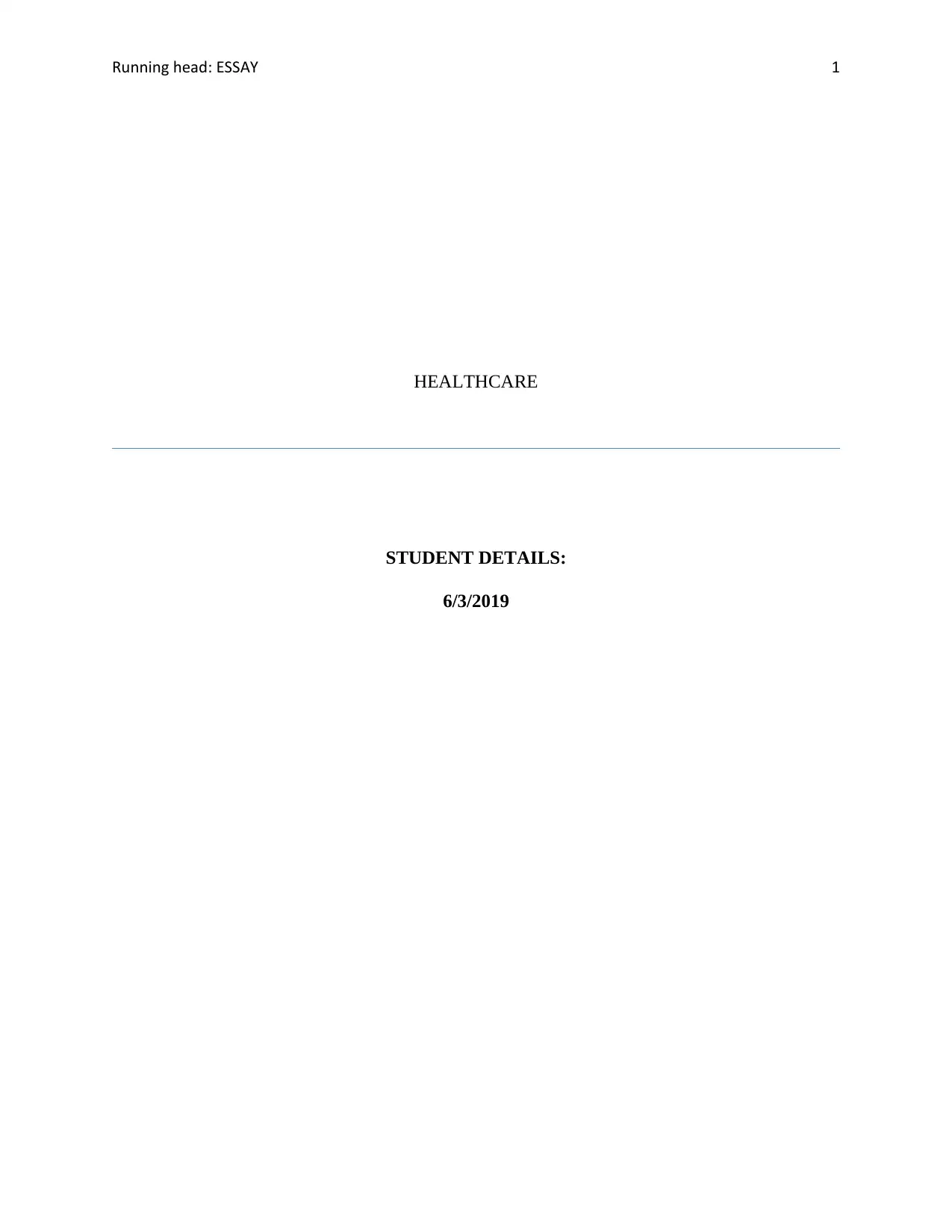
Running head: ESSAY 1
HEALTHCARE
STUDENT DETAILS:
6/3/2019
HEALTHCARE
STUDENT DETAILS:
6/3/2019
Paraphrase This Document
Need a fresh take? Get an instant paraphrase of this document with our AI Paraphraser
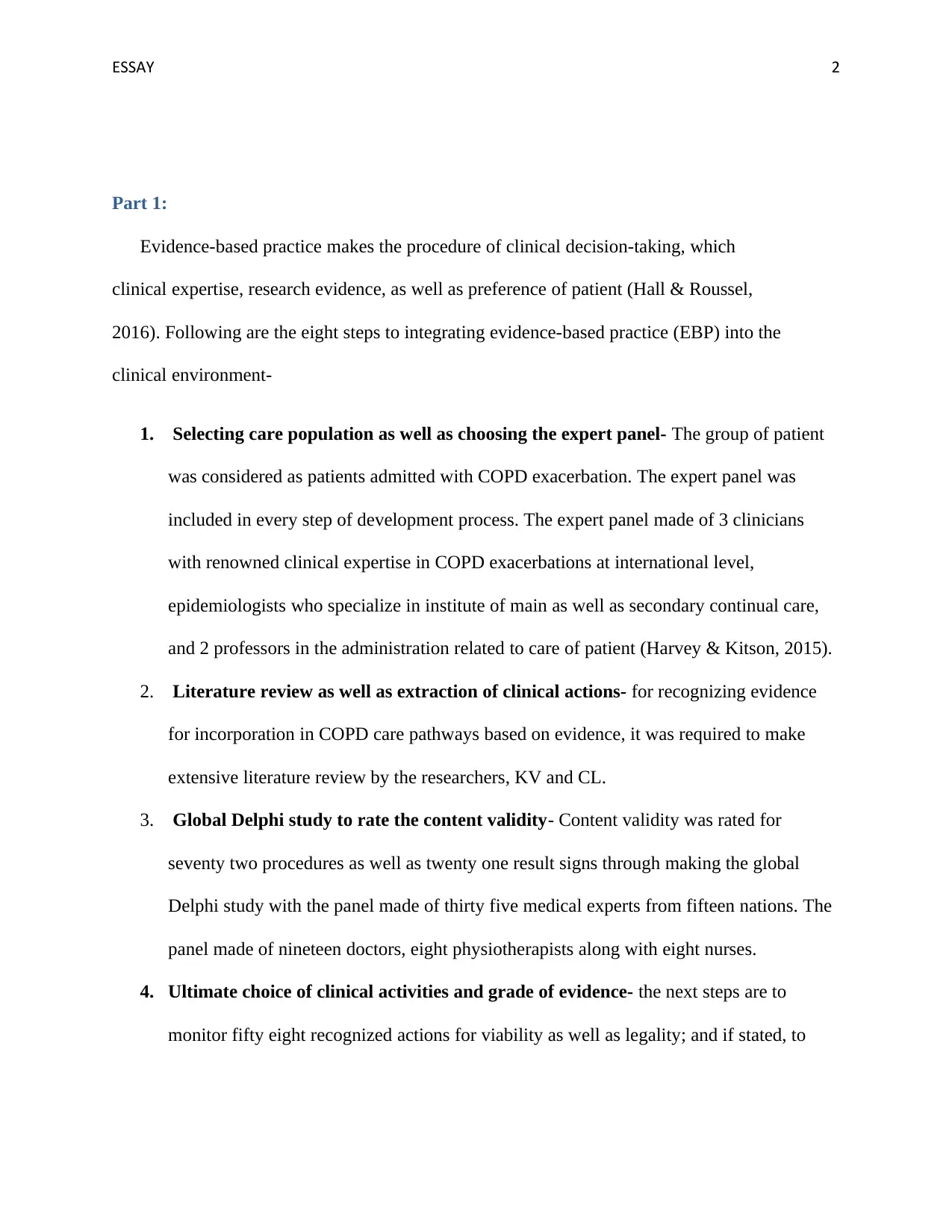
ESSAY 2
Part 1:
Evidence-based practice makes the procedure of clinical decision-taking, which
clinical expertise, research evidence, as well as preference of patient (Hall & Roussel,
2016). Following are the eight steps to integrating evidence-based practice (EBP) into the
clinical environment-
1. Selecting care population as well as choosing the expert panel- The group of patient
was considered as patients admitted with COPD exacerbation. The expert panel was
included in every step of development process. The expert panel made of 3 clinicians
with renowned clinical expertise in COPD exacerbations at international level,
epidemiologists who specialize in institute of main as well as secondary continual care,
and 2 professors in the administration related to care of patient (Harvey & Kitson, 2015).
2. Literature review as well as extraction of clinical actions- for recognizing evidence
for incorporation in COPD care pathways based on evidence, it was required to make
extensive literature review by the researchers, KV and CL.
3. Global Delphi study to rate the content validity- Content validity was rated for
seventy two procedures as well as twenty one result signs through making the global
Delphi study with the panel made of thirty five medical experts from fifteen nations. The
panel made of nineteen doctors, eight physiotherapists along with eight nurses.
4. Ultimate choice of clinical activities and grade of evidence- the next steps are to
monitor fifty eight recognized actions for viability as well as legality; and if stated, to
Part 1:
Evidence-based practice makes the procedure of clinical decision-taking, which
clinical expertise, research evidence, as well as preference of patient (Hall & Roussel,
2016). Following are the eight steps to integrating evidence-based practice (EBP) into the
clinical environment-
1. Selecting care population as well as choosing the expert panel- The group of patient
was considered as patients admitted with COPD exacerbation. The expert panel was
included in every step of development process. The expert panel made of 3 clinicians
with renowned clinical expertise in COPD exacerbations at international level,
epidemiologists who specialize in institute of main as well as secondary continual care,
and 2 professors in the administration related to care of patient (Harvey & Kitson, 2015).
2. Literature review as well as extraction of clinical actions- for recognizing evidence
for incorporation in COPD care pathways based on evidence, it was required to make
extensive literature review by the researchers, KV and CL.
3. Global Delphi study to rate the content validity- Content validity was rated for
seventy two procedures as well as twenty one result signs through making the global
Delphi study with the panel made of thirty five medical experts from fifteen nations. The
panel made of nineteen doctors, eight physiotherapists along with eight nurses.
4. Ultimate choice of clinical activities and grade of evidence- the next steps are to
monitor fifty eight recognized actions for viability as well as legality; and if stated, to
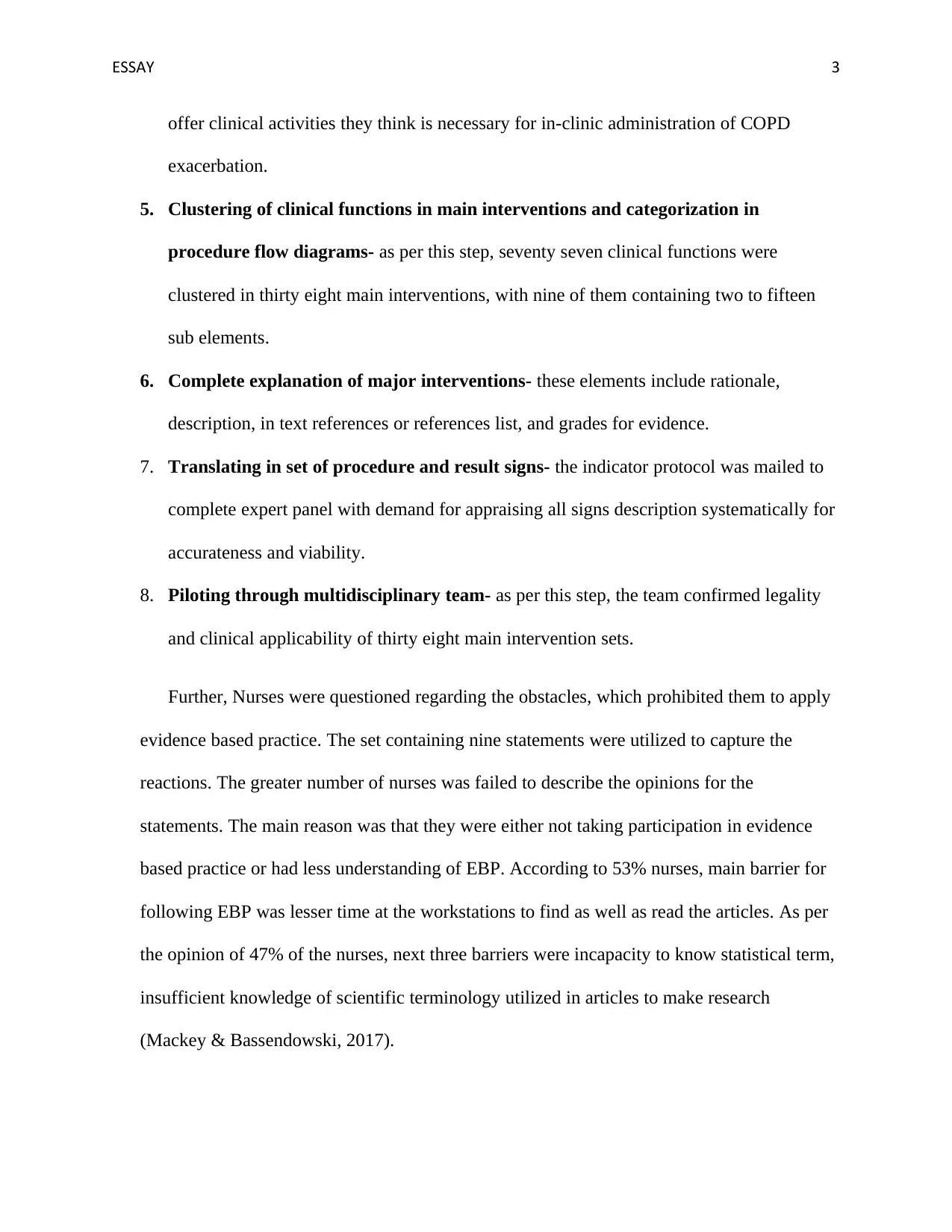
ESSAY 3
offer clinical activities they think is necessary for in-clinic administration of COPD
exacerbation.
5. Clustering of clinical functions in main interventions and categorization in
procedure flow diagrams- as per this step, seventy seven clinical functions were
clustered in thirty eight main interventions, with nine of them containing two to fifteen
sub elements.
6. Complete explanation of major interventions- these elements include rationale,
description, in text references or references list, and grades for evidence.
7. Translating in set of procedure and result signs- the indicator protocol was mailed to
complete expert panel with demand for appraising all signs description systematically for
accurateness and viability.
8. Piloting through multidisciplinary team- as per this step, the team confirmed legality
and clinical applicability of thirty eight main intervention sets.
Further, Nurses were questioned regarding the obstacles, which prohibited them to apply
evidence based practice. The set containing nine statements were utilized to capture the
reactions. The greater number of nurses was failed to describe the opinions for the
statements. The main reason was that they were either not taking participation in evidence
based practice or had less understanding of EBP. According to 53% nurses, main barrier for
following EBP was lesser time at the workstations to find as well as read the articles. As per
the opinion of 47% of the nurses, next three barriers were incapacity to know statistical term,
insufficient knowledge of scientific terminology utilized in articles to make research
(Mackey & Bassendowski, 2017).
offer clinical activities they think is necessary for in-clinic administration of COPD
exacerbation.
5. Clustering of clinical functions in main interventions and categorization in
procedure flow diagrams- as per this step, seventy seven clinical functions were
clustered in thirty eight main interventions, with nine of them containing two to fifteen
sub elements.
6. Complete explanation of major interventions- these elements include rationale,
description, in text references or references list, and grades for evidence.
7. Translating in set of procedure and result signs- the indicator protocol was mailed to
complete expert panel with demand for appraising all signs description systematically for
accurateness and viability.
8. Piloting through multidisciplinary team- as per this step, the team confirmed legality
and clinical applicability of thirty eight main intervention sets.
Further, Nurses were questioned regarding the obstacles, which prohibited them to apply
evidence based practice. The set containing nine statements were utilized to capture the
reactions. The greater number of nurses was failed to describe the opinions for the
statements. The main reason was that they were either not taking participation in evidence
based practice or had less understanding of EBP. According to 53% nurses, main barrier for
following EBP was lesser time at the workstations to find as well as read the articles. As per
the opinion of 47% of the nurses, next three barriers were incapacity to know statistical term,
insufficient knowledge of scientific terminology utilized in articles to make research
(Mackey & Bassendowski, 2017).
⊘ This is a preview!⊘
Do you want full access?
Subscribe today to unlock all pages.

Trusted by 1+ million students worldwide
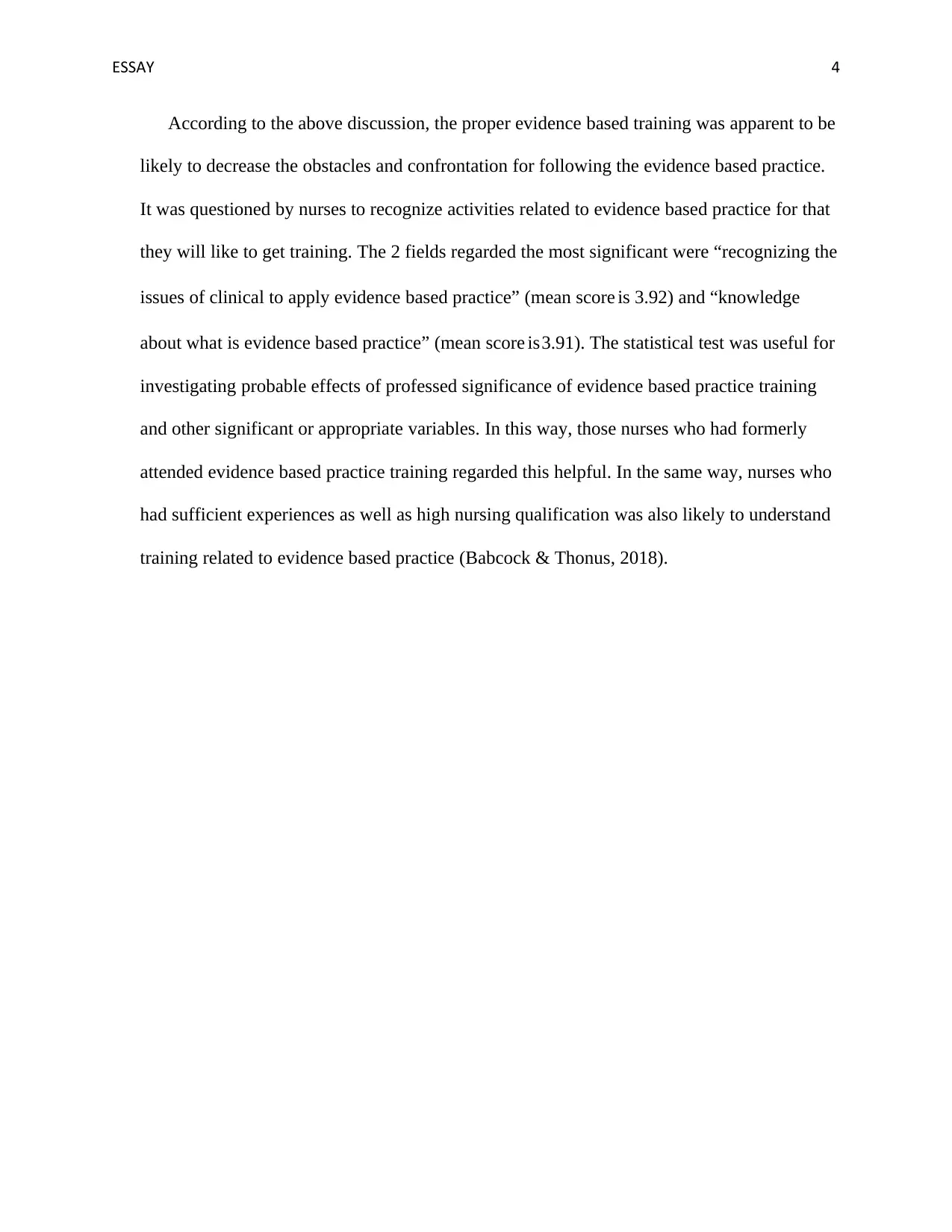
ESSAY 4
According to the above discussion, the proper evidence based training was apparent to be
likely to decrease the obstacles and confrontation for following the evidence based practice.
It was questioned by nurses to recognize activities related to evidence based practice for that
they will like to get training. The 2 fields regarded the most significant were “recognizing the
issues of clinical to apply evidence based practice” (mean score is 3.92) and “knowledge
about what is evidence based practice” (mean score is 3.91). The statistical test was useful for
investigating probable effects of professed significance of evidence based practice training
and other significant or appropriate variables. In this way, those nurses who had formerly
attended evidence based practice training regarded this helpful. In the same way, nurses who
had sufficient experiences as well as high nursing qualification was also likely to understand
training related to evidence based practice (Babcock & Thonus, 2018).
According to the above discussion, the proper evidence based training was apparent to be
likely to decrease the obstacles and confrontation for following the evidence based practice.
It was questioned by nurses to recognize activities related to evidence based practice for that
they will like to get training. The 2 fields regarded the most significant were “recognizing the
issues of clinical to apply evidence based practice” (mean score is 3.92) and “knowledge
about what is evidence based practice” (mean score is 3.91). The statistical test was useful for
investigating probable effects of professed significance of evidence based practice training
and other significant or appropriate variables. In this way, those nurses who had formerly
attended evidence based practice training regarded this helpful. In the same way, nurses who
had sufficient experiences as well as high nursing qualification was also likely to understand
training related to evidence based practice (Babcock & Thonus, 2018).
Paraphrase This Document
Need a fresh take? Get an instant paraphrase of this document with our AI Paraphraser
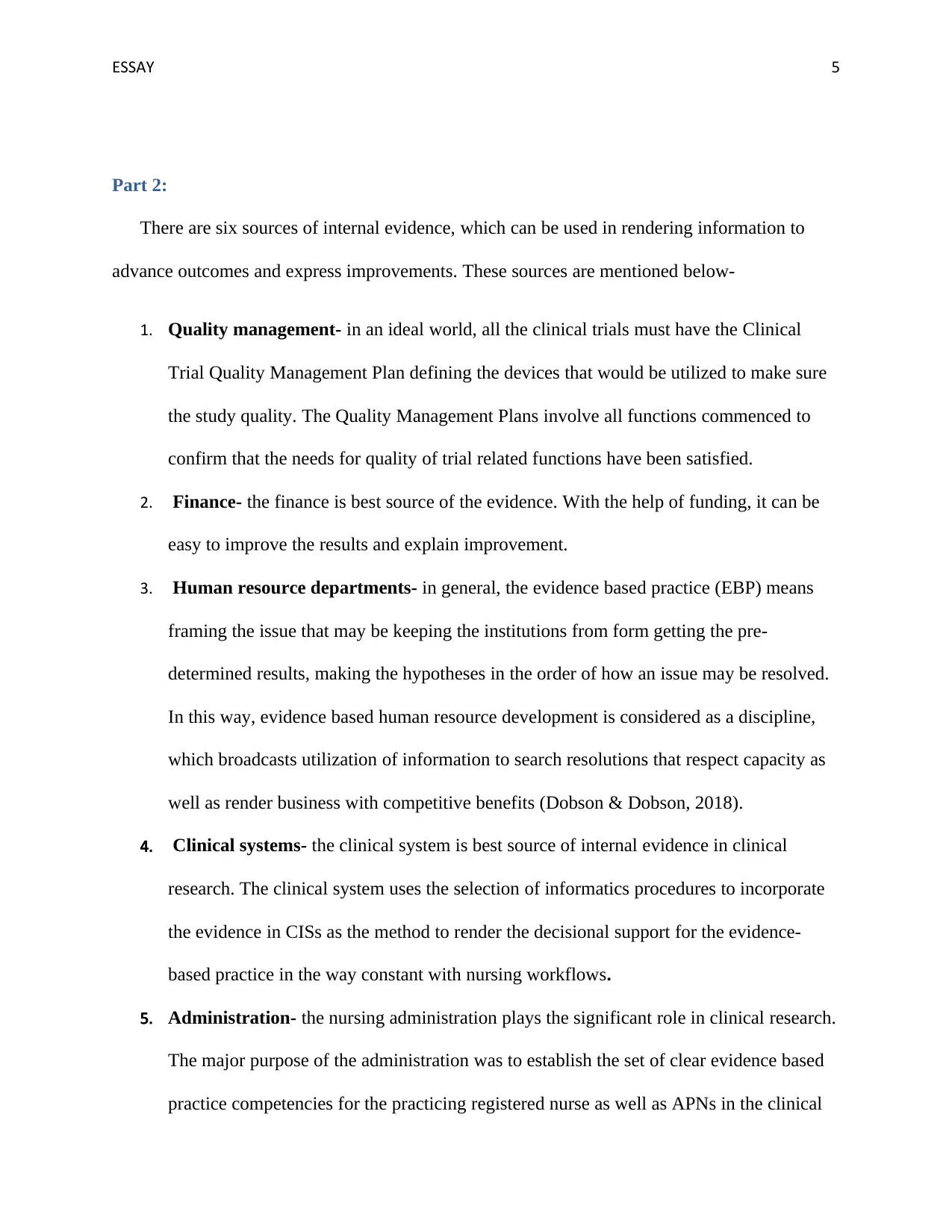
ESSAY 5
Part 2:
There are six sources of internal evidence, which can be used in rendering information to
advance outcomes and express improvements. These sources are mentioned below-
1. Quality management- in an ideal world, all the clinical trials must have the Clinical
Trial Quality Management Plan defining the devices that would be utilized to make sure
the study quality. The Quality Management Plans involve all functions commenced to
confirm that the needs for quality of trial related functions have been satisfied.
2. Finance- the finance is best source of the evidence. With the help of funding, it can be
easy to improve the results and explain improvement.
3. Human resource departments- in general, the evidence based practice (EBP) means
framing the issue that may be keeping the institutions from form getting the pre-
determined results, making the hypotheses in the order of how an issue may be resolved.
In this way, evidence based human resource development is considered as a discipline,
which broadcasts utilization of information to search resolutions that respect capacity as
well as render business with competitive benefits (Dobson & Dobson, 2018).
4. Clinical systems- the clinical system is best source of internal evidence in clinical
research. The clinical system uses the selection of informatics procedures to incorporate
the evidence in CISs as the method to render the decisional support for the evidence-
based practice in the way constant with nursing workflows.
5. Administration- the nursing administration plays the significant role in clinical research.
The major purpose of the administration was to establish the set of clear evidence based
practice competencies for the practicing registered nurse as well as APNs in the clinical
Part 2:
There are six sources of internal evidence, which can be used in rendering information to
advance outcomes and express improvements. These sources are mentioned below-
1. Quality management- in an ideal world, all the clinical trials must have the Clinical
Trial Quality Management Plan defining the devices that would be utilized to make sure
the study quality. The Quality Management Plans involve all functions commenced to
confirm that the needs for quality of trial related functions have been satisfied.
2. Finance- the finance is best source of the evidence. With the help of funding, it can be
easy to improve the results and explain improvement.
3. Human resource departments- in general, the evidence based practice (EBP) means
framing the issue that may be keeping the institutions from form getting the pre-
determined results, making the hypotheses in the order of how an issue may be resolved.
In this way, evidence based human resource development is considered as a discipline,
which broadcasts utilization of information to search resolutions that respect capacity as
well as render business with competitive benefits (Dobson & Dobson, 2018).
4. Clinical systems- the clinical system is best source of internal evidence in clinical
research. The clinical system uses the selection of informatics procedures to incorporate
the evidence in CISs as the method to render the decisional support for the evidence-
based practice in the way constant with nursing workflows.
5. Administration- the nursing administration plays the significant role in clinical research.
The major purpose of the administration was to establish the set of clear evidence based
practice competencies for the practicing registered nurse as well as APNs in the clinical
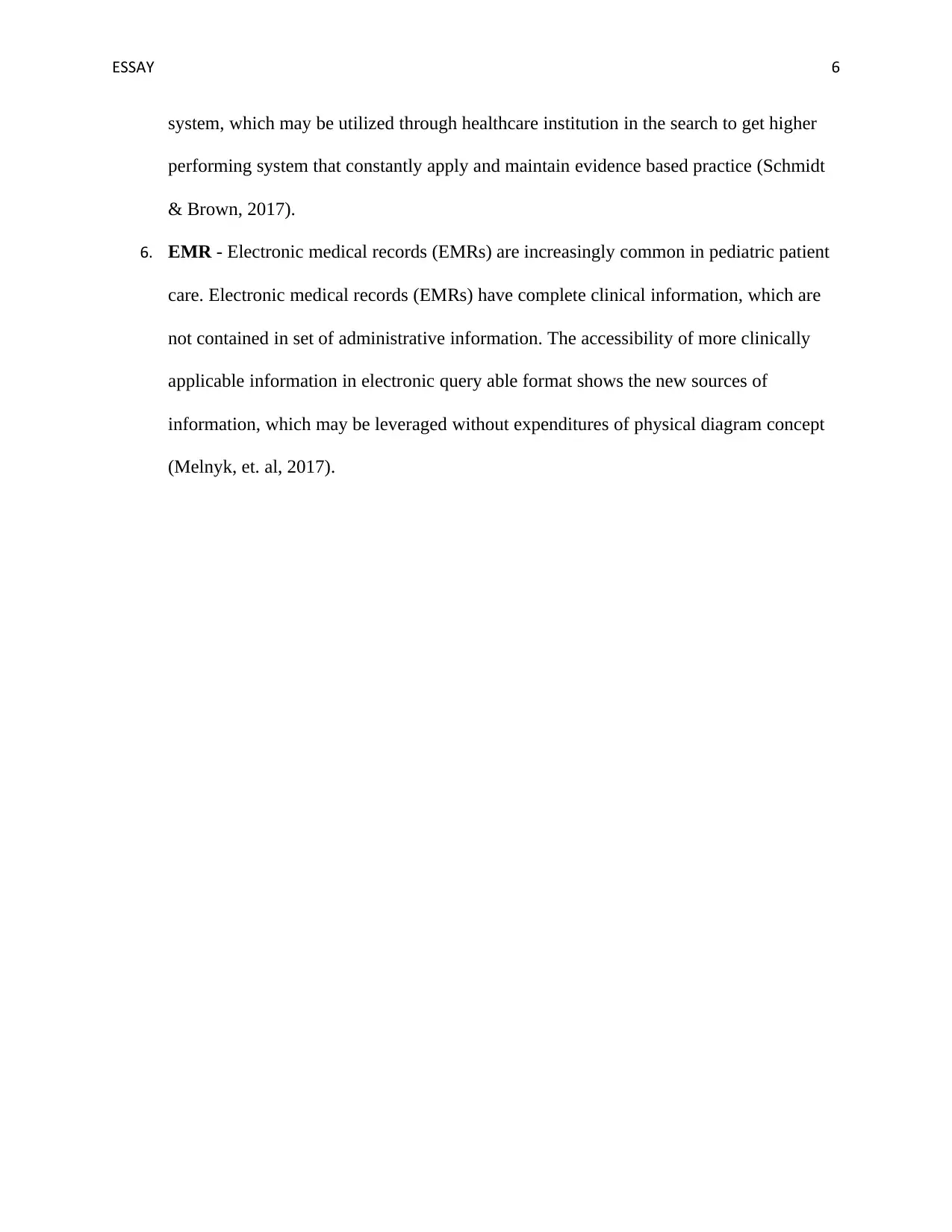
ESSAY 6
system, which may be utilized through healthcare institution in the search to get higher
performing system that constantly apply and maintain evidence based practice (Schmidt
& Brown, 2017).
6. EMR - Electronic medical records (EMRs) are increasingly common in pediatric patient
care. Electronic medical records (EMRs) have complete clinical information, which are
not contained in set of administrative information. The accessibility of more clinically
applicable information in electronic query able format shows the new sources of
information, which may be leveraged without expenditures of physical diagram concept
(Melnyk, et. al, 2017).
system, which may be utilized through healthcare institution in the search to get higher
performing system that constantly apply and maintain evidence based practice (Schmidt
& Brown, 2017).
6. EMR - Electronic medical records (EMRs) are increasingly common in pediatric patient
care. Electronic medical records (EMRs) have complete clinical information, which are
not contained in set of administrative information. The accessibility of more clinically
applicable information in electronic query able format shows the new sources of
information, which may be leveraged without expenditures of physical diagram concept
(Melnyk, et. al, 2017).
⊘ This is a preview!⊘
Do you want full access?
Subscribe today to unlock all pages.

Trusted by 1+ million students worldwide
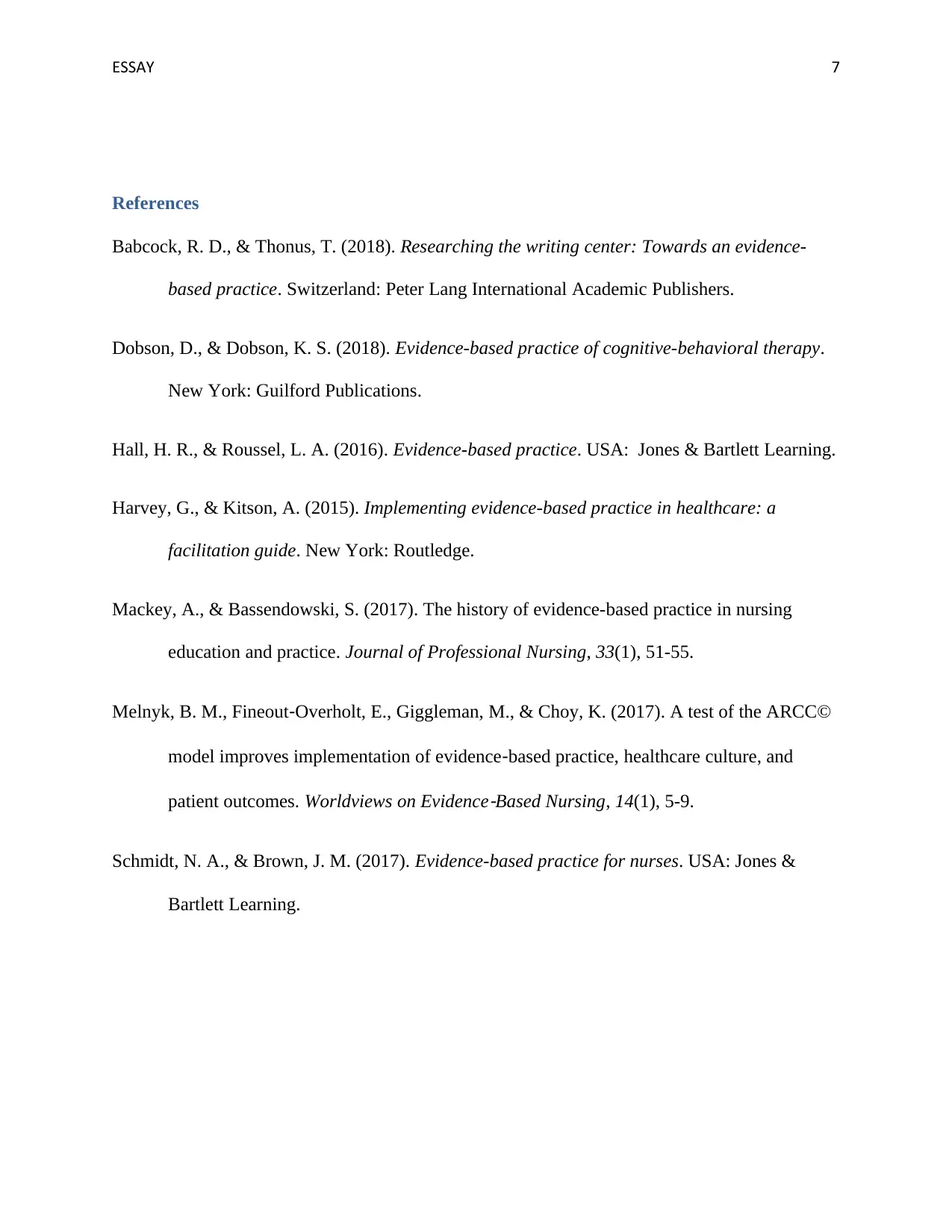
ESSAY 7
References
Babcock, R. D., & Thonus, T. (2018). Researching the writing center: Towards an evidence-
based practice. Switzerland: Peter Lang International Academic Publishers.
Dobson, D., & Dobson, K. S. (2018). Evidence-based practice of cognitive-behavioral therapy.
New York: Guilford Publications.
Hall, H. R., & Roussel, L. A. (2016). Evidence-based practice. USA: Jones & Bartlett Learning.
Harvey, G., & Kitson, A. (2015). Implementing evidence-based practice in healthcare: a
facilitation guide. New York: Routledge.
Mackey, A., & Bassendowski, S. (2017). The history of evidence-based practice in nursing
education and practice. Journal of Professional Nursing, 33(1), 51-55.
Melnyk, B. M., Fineout‐Overholt, E., Giggleman, M., & Choy, K. (2017). A test of the ARCC©
model improves implementation of evidence‐based practice, healthcare culture, and
patient outcomes. Worldviews on Evidence
‐Based Nursing, 14(1), 5-9.
Schmidt, N. A., & Brown, J. M. (2017). Evidence-based practice for nurses. USA: Jones &
Bartlett Learning.
References
Babcock, R. D., & Thonus, T. (2018). Researching the writing center: Towards an evidence-
based practice. Switzerland: Peter Lang International Academic Publishers.
Dobson, D., & Dobson, K. S. (2018). Evidence-based practice of cognitive-behavioral therapy.
New York: Guilford Publications.
Hall, H. R., & Roussel, L. A. (2016). Evidence-based practice. USA: Jones & Bartlett Learning.
Harvey, G., & Kitson, A. (2015). Implementing evidence-based practice in healthcare: a
facilitation guide. New York: Routledge.
Mackey, A., & Bassendowski, S. (2017). The history of evidence-based practice in nursing
education and practice. Journal of Professional Nursing, 33(1), 51-55.
Melnyk, B. M., Fineout‐Overholt, E., Giggleman, M., & Choy, K. (2017). A test of the ARCC©
model improves implementation of evidence‐based practice, healthcare culture, and
patient outcomes. Worldviews on Evidence
‐Based Nursing, 14(1), 5-9.
Schmidt, N. A., & Brown, J. M. (2017). Evidence-based practice for nurses. USA: Jones &
Bartlett Learning.
1 out of 7
Related Documents
Your All-in-One AI-Powered Toolkit for Academic Success.
+13062052269
info@desklib.com
Available 24*7 on WhatsApp / Email
![[object Object]](/_next/static/media/star-bottom.7253800d.svg)
Unlock your academic potential
Copyright © 2020–2025 A2Z Services. All Rights Reserved. Developed and managed by ZUCOL.



